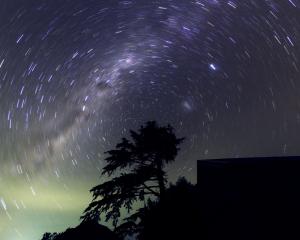Max Quinn has spent half a century telling stories, many of them gathered at the ends of the earth, Kim Dungey reports.
The polar bear paces back and forth only 20m away. Alone on the Arctic sea ice, Max Quinn is being stalked by a 200kg mammal that is all teeth, claws and aggression.

Getting close to the world's wildlife is not unusual for the veteran cameraman; he has also filmed venomous snakes, coyotes and bobcats in the desert. But polar bears are the Arctic's top predators and this one is not only protective of her cubs. After spending all winter in a den, she is hungry.
Quinn is there to film a researcher tranquillising the bear from a helicopter, then landing a short time later to give her a health check.
"The [helicopter] buzzed off way out on to the horizon and the bear went down after about two minutes, which is what he said would happen,'' he explains. "But then she got up ... and got a sniff of me.''
As the agitated bear approached him and walked away, approached again, Quinn felt no fear and completely forgot about the rifle he had been given: "I was so in awe of what was going on.''
Then he took his eye away from the viewfinder and realised how close she was.
"Eventually she did go down but it took over 10 minutes for the drug to take effect. Apparently the dart hadn't quite gone into the fatty tissue correctly.''
Disaster averted, the Dunedin cameraman and director went on to spend many more years filming elusive wildlife in extreme locations. He is now celebrating 50 years of film-making, 30 of them with Natural History New Zealand Ltd (NHNZ), making documentaries for the likes of Discovery Channel and National Geographic. He recently turned 67.
"I should be retired I suppose but I can't get it out of my blood. Hopefully I've got a year or two left in me.''
Always interested in natural history, Quinn was a shy child who practised taxidermy on classmates' dead budgies and ran a museum at his Wellington primary school. Other pupils displayed their shells and fossils; he took along a jaguar's head which his grandfather had acquired in South America. He also used an 8mm movie camera to film animals through the cages at Wellington Zoo and to record brother Keith, a future sports commentator, playing rugby.
At 17, he joined the New Zealand Broadcasting Corporation as a trainee cameraman, going on to film news stories and dramas, then direct children's programmes. However, it was TVNZ's Dunedin-based natural history unit that he had his eyes on and eventually he was able to return to his original passion.

In 1991, he and sound man Don Anderson braved blizzards, crevasses and temperatures as low as minus 50degC to film the emperor penguin, the only penguin species that breeds during the Antarctic winter.
The pair were on the ice for 11 months - four of them in total darkness - and regularly drove seven hours from Scott Base to their huts, then tramped an hour to the penguin colony.
The first people to film emperor penguin chicks hatching and the male birds transferring the chicks to the females after balancing the eggs on their feet for 60 days, the pair celebrated by chipping ice from the inside wall of their hut and having a whisky.
Quinn has also joined Inuit whalers in the Arctic Circle and Laplanders, complete with skidoos and cellphones, herding thousands of reindeer in Norway. In Oymyakon, Siberia, it was minus 48degC when the NHNZ team blew up a big barrel of boiling water and watched it turn to ice instantly: "It went up like an atomic bomb. I had it covered with about 10 different cameras.''
But his career hasn't all been about cold climates. He has also filmed New Zealand's marine environments for the ocean series Our Big Blue Backyard, been cameraman for the last four series of Abalone Wars and travelled to China to direct three episodes of Megastructures.
Last year he spent a month in the thin air of the Tibetan plateau, filmed the diverse creatures that have adapted to life in Arizona's Sonoran Desert - everything from tarantulas to burrowing owls and stocky chuckwalla lizards - and used a Gopro to capture rare footage of a fernbird feeding its chicks in a nest close to the ground in the predator-free Orokonui ecosanctuary.

A "lost tribe'' of southern right whales, discovered in the Southern Ocean after more than a century of near extinction, rubbed their backs on his Zodiac and spy-hopped right next to him: "We'd be thinking there were no whales in the area and suddenly this huge behemoth would come rearing up out of the sea just to have a look at us.''
The work is not as glamorous as it sounds. Tents and tummy bugs are regular features; his backpack loaded with his Sony FS7 camera, tripod, lenses and other gear, weighs more than 50kg. And at 195cm tall, he finds it uncomfortable sitting in a hide for hours on end, equipped with only a thermos flask, powdered orange juice, muesli bars or peanut butter and jelly sandwiches.
"I don't put a Walkman or anything on because as soon as I have music playing, it takes me away from the scene. You just have to be observant.''
He once waited nine hours - half of it in driving rain - for a New Zealand fur seal to give birth, then missed the event when his camera battery died: "I was so pissed. It's not the sort of story you want to tell anyone.''
Getting shots of interesting behaviour - a mating, predation or feeding sequence - is key.
Having started out on 16mm black-and-white film, he now shoots ultra high-definition (4K) video and has also seen changes in the way film-makers approach their work. Where once they would spend a year with a single species, they now tend to focus on an environment and provide "snapshots'' of the many animals that live within it.
Some have been criticised for staging scenes or passing captive animals off as wild ones, even the renowned David Attenborough taking flak after narrating a scene in which a polar bear appeared to be giving birth in the wild but was actually being filmed in a zoo using fake snow.
Quinn has also occasionally filmed close-ups in studios or enclosures, insisting this is legitimate if it avoids disturbing wild animals and the behaviour exhibited is the same as they would display in the natural world.

Colleagues talk of Quinn's patience, his ability to think in sequences when he is filming and his wildlife knowledge, which enables him to predict behaviour.
Former NHNZ managing director Michael Stedman says he is the most versatile film-maker he has come across and is also unflappable, even in the world's most hostile environments. Quinn had made at least 15 polar films and his skills as a director and cameraman meant he would often need only a soundperson with him.
"His great love of the polar regions and his fascination with science has given the world a greater understanding of the importance of Antarctic research ... His work on ozone layers, the science of the poles and the drilling programmes looking at climate, told us what has happened on planet Earth and therefore gives us some indication as to what the future holds. His understanding, and the extent to which he will go to tell stories, I think is just extraordinary.''
NHNZ managing director Kyle Murdoch, who joined the company on a short-term contract after university, remembers being inspired by the "intrepid, adventurous and windswept producer and cameraman who overwintered in Antarctica and travelled the world in search of unique stories''.
And that status had only grown recently, with stories of him "racing around at high altitude'' in Tibet carrying heavy camera gear, his fitness surpassing that of local crews: "I'll be at an event with senior, high-ranking China Central Television executives and they all want to ask about this mighty Max Quinn bloke.''
At the end of these trips, Quinn returns to wife Carol, an administration assistant at the University of Otago, and the wildlife surrounding their home on the northwestern shore of Otago Harbour. Binoculars on the kitchen bench provide close-up views of spoonbills, swans, herons and kingfishers.
A display case contains mementoes from his journeys: a reindeer herder's knife, woolly mammoth ivory and baskets woven by the last full-blood Yaghan people, whom he filmed on islands off the southernmost tip of South America.
In the basement, hundreds of photos from Earth's southernmost continent await sorting later this winter: "We call this my polar room,'' he says, looking around with a laugh.
"It's the sort of place I'll be able to mull over my life, drink beer with my mates and talk a load of nonsense.''
The room's contents reveal Quinn's passion for Antarctic history (he is said to have an encyclopaedic knowledge of polar exploration) and for family history; his father, who died when he was 5, was a West Coast coal miner.
A regular at Highlanders' matches, he also enjoys solitary pursuits like fishing, classical music and pottering in the garden. He's pleased he no longer shoots dramas because he would always be surrounded by people: "I'm a bit of a loner and when you're making natural history films, you can be on your own out in the wilds.''
Twelve kilometres away in his Dunedin office, two images illustrate the lengths he will go to if he thinks it is important to telling a story. One is a clip on his computer of a nuclear submarine surfacing through the Arctic sea ice. When Quinn heard this was about to happen, he gained permission from the US Navy to film it.
Six years before An Inconvenient Truth raised awareness of global warming, the footage was used in a documentary about the poles driving global climate systems and became a metaphor for the thinning of the polar sea ice.
The other is a small photo of a large, orange-ish brown cat in a plastic container. A wildlife authority in the Arizonan desert had a dead bobcat in a freezer and a biologist suggested using it to attract animals close to the camera, he explains.
"I had to thaw it out so I bought a plastic case and sat it in the bath in my hotel room.''
Each day, to avoid shocking the women who cleaned his room, he transferred the cat to his wardrobe before leaving. The carcass smelled of freezer burn and failed to attract any vultures. But working on his own, he has to be innovative.
"It's the sort of thing you have to do to survive out in the field and to come back with some good footage.''
Natural History New Zealand Ltd is in its 40th year of operation. In the TVNZ days, it was known as the wildlife unit, then the natural history unit until being sold to Fox in 1996. It is now owned by Australian David Haslingden, a former Fox executive.
















